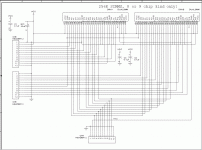Eudimorphodon
Veteran Member
Another item on my to-do list:
After a working floppy disk controller finally fell into my lap I decided to pull the pair of CoCo3's I've had forever out of storage and play with them. A thing I have rapidly realized is that a 128K CoCo3 is sort of useless for running much CoCo3 specific software. Apparently last year someone was selling a very inexpensive 512K upgrade board called the "Boomerang", but since that source seems to have dried up I'm evaluating if it's worth trying to brew one up myself.
Maybe I'm just bad at Google lately but searching for schematics for a memory expansion came up (mostly) snake-eyes. The CoCo3 service manual doesn't include the pinouts of the connectors, it just shows the original board using 41256s in an inset, but I did eventually manage to find the schematic for a 30-pin SIMM-based homebrew expansion in archive.org's wayback machine that did have the pinouts. Having stared at it all while scratching my head for a while I have some observations, I wonder if anyone here can sanity check them:
After a working floppy disk controller finally fell into my lap I decided to pull the pair of CoCo3's I've had forever out of storage and play with them. A thing I have rapidly realized is that a 128K CoCo3 is sort of useless for running much CoCo3 specific software. Apparently last year someone was selling a very inexpensive 512K upgrade board called the "Boomerang", but since that source seems to have dried up I'm evaluating if it's worth trying to brew one up myself.
Maybe I'm just bad at Google lately but searching for schematics for a memory expansion came up (mostly) snake-eyes. The CoCo3 service manual doesn't include the pinouts of the connectors, it just shows the original board using 41256s in an inset, but I did eventually manage to find the schematic for a 30-pin SIMM-based homebrew expansion in archive.org's wayback machine that did have the pinouts. Having stared at it all while scratching my head for a while I have some observations, I wonder if anyone here can sanity check them:
- It looks like the CoCo3 *sort of* has a 16 bit memory bus? It's confusing on the schematics because they gave both sets of 8 data lines the same designation, but from what I can tell the memory array is wired so all reads are 16 bit wide (there's only one CAS line to both banks of DRAM) and the individual hi/lo bytes are latched in a pair of 74LS374s. The "other" side of those latches goes back to an 8 bit wide bus.
- It looks like writes are solely 8 bits wide, coming through a pair of '244 buffers, and there are two separate sets of WE signals for each bank?
- Does anyone know of a common 256kx8 (or anything in that size ballpark) SRAM that has a multiplexed data bus with DRAM compatible signaling? I just chuck that out there because the "Triad" (and I think the Boomerang as well) say they're SRAM based, but all the SRAMs I know of have non-multiplexed busses, and I don't *see* a latch on those boards to unmultiplex the addresses. Maybe they used a tiny surface mount part.
- Looking at 256K x 16 bit wide DRAM parts it seems like the way Tandy did it is a little bass-akwards? There are separate WE lines but a common CAS, so... when a write is happening to one of the 8-bit halves does this mean a read is coming out of the other? (Since the CASes are common.) This seems to rule out just using one of those 256kx16 parts?

